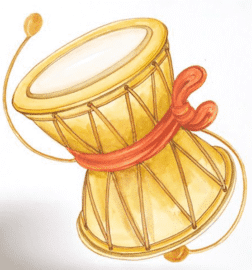
Temple As Parallel Governance Model
Introduction:
Institutions are not natural state for any beings in nature, natural forces by themselves are eternal institutions, which is aptly articulated in the identity “Sanatana Dharma”, the eternal law of existence which is natural to be followed by all. It is only the Humans who create artificial institutions for specific purposes. The capability to create and follow institutional structure is what separates Humans from other beings. Institutions are also what separates one set of Humans to the other set of humans, in the sophistication of their life, it is reflected. Understanding the nature and need for institutions explains the strands of civilization. Even though natural forces are eternal, Physical (existence) and metaphysical (Logical) institutions are not eternal. They rise and fall like waves in the ocean.
The lifespan and vitality of an institution depend on its Bijakas (seed-givers/founders) and Poṣhakas (nurturers/supporters). The strength of these roots determines the life span of the institution and whether an institution merely survives or evolves, thrives, and endures across generations.
Just as humans go through the stages of Balya (nourishment/childhood), Yauvana (sustenance/youth), and Vruddhavastha (withdrawal/old age), this cycle of life applies to all living beings. Similarly, institutions also follow this natural life cycle.
So, there is always a need for alternative or parallel institutions in society and the society should be ready with an alternative to fill institutional vacuum before an existing setup becomes ineffective or a troublemaker. Even if a society is not ready for an effective alternative, eternal existence will find an alternative which may not be desirable and perfect, for solving the existing decaying institution.
Concept:
Emerging Institutions should be created using existing identities in society, nothing comes out of vaccum. Temples are part of Bharatia civilization from millenniums in different forms, there were multiple parallel and integrated institutions to Temples. Temples acted as integration institution for multiple other interconnected and interdependent institutions which were weaved as civilization through rituals, festivals, Donations, beliefs and many other social activities. Such institutions were concocted as culture by people who don’nt understand these. Due to this misunderstanding, instead of revitalizing the civilizational skeleton structure according to latest societal changes and needs, those institutions were character assassinated and maligned which acted as a catalyst for their decay. This resulted in our nation accepting foreign institutions. The word popularly used as “Swatantra” has become a misnomer, because currently Bharatia Tantra is no more, we are para tantra, i.e. using foreign institutions. Reviving and rewriting Institutions should be a way to reclaim and establish true Swatantra.
Institutional design in a nation should be a way to access and organize human resources from sophisticated to the most corner people of society, it should include other living beings and nature.
Implementation:
Institutions are created in the minds and habits of people and society. These institutions stand on the four pillars of Dharma, Artha, Kaama, and Moksha. Each of these pillars, in turn, requires foundational support. Smaller institutions, which act as supporting entities, should be identified or built. The purpose of identifying or creating these smaller institutions is to establish a robust support system that, in turn, sustains larger, more expansive institutions. These interdependent institutions should be thoughtfully woven together, linking all aspects related to temples, people, and society.
A concept of Natha and Anatha Temple needs to be established. Anatha Temples which are not yet weaved into the bureaucratic structure of larger interdependent institutions should be transformed into Natha temples, which is a larger set of interconnected institutions spread across world. In this age of rapid transportation all Natha Temples should be international institutions with individual local temple point called Renuka.
The Rise of institutions follows Triguna Paddhati of Indrajalam, Maya, Upeksha , where the eternal craving of sense organs of people and society should be provided means of attraction i.e. Indrajalam , through gravitational points, which act as pull factor for bringing and binding masses together. Through Maya, the eternal illusion of design, helps in deploying metamorphosis institutional structure creating parallel civilizational institutions fulfilling requirement in a diverse society. Upeksha helps to keep sanctity of the institutions and protects them from disturbances by being detached and accessible only for the worthy.


Ashok kumar kachraj
Swamy Narayan temples & lSCON temples are attempts in this direction. Sply Swamy Narayan Temple inAbuDhabi is one such attempt.
Isha foundationis also adopting like this.
And how about Shirdi Sai Sansthans and TTD efforts in this direction.
You can find swatantra in paratantra. Transformation as per need of society is essential.